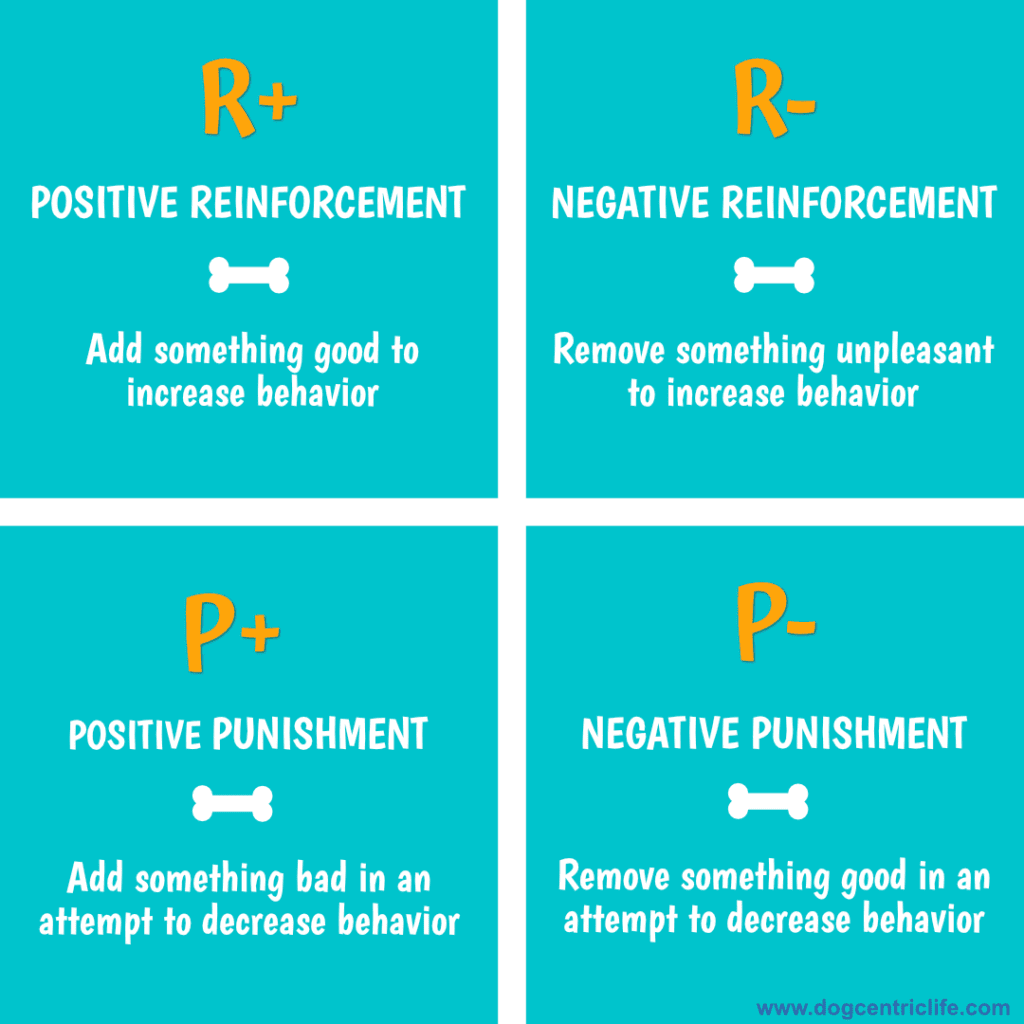Understanding how dogs learn helps us to interpret why certain behaviors occur. This is very helpful if you happen to be trying to train your own dog! For dogs, learning doesn’t just happen when we are trying to train a dog to “sit”… it is happening all the time… even when we’re not intentionally trying to train dogs. Day to day life offers plenty of opportunities for dogs to learn… in either a positive or negative manner.
What is learning theory?
Basically, learning theory is what we use to explain how learning works. When we look at dogs (and all animals, including humans) there are two styles through which learning occurs… classical conditioning and operant conditioning.
classical conditioning
Classical conditioning is learning that occurs by association and happens involuntarily. This plays a major role in how your dog reacts to the environment as your dog develops either positive or negative associations with all the various stimuli that exists in the world around them. You may not realize it, but classical conditioning occurs every day… everywhere… with and without our help.
As an example, our dog, Ollie, used to get super excited when he heard the sound of keys jingling. Now, keys themselves, have no meaning to dogs… why would they? But for Ollie (and many other dogs) the sound of the keys meant they may get to go for a car ride, or go to the park, or go out for a walk! The excitement your dogs feels has become paired with the sound of jingling keys – now the keys is all they need to hear to get exited. This association has been learned through classical conditioning. Another example could be when the doorbell rings and your dog gets excited. They get excited because they have learned to associate the doorbell ringing with visitors coming – which many dogs love!
Classical conditioning is an incredibly powerful training tool… and if you have a puppy it is worthwhile learning more about it. This style of learning is incredibly useful when socializing your puppy. As you introduce your puppy to new stimuli (kids, people, places, things, etc) in their environment the process of feeding treats in the presence of a specific stimulus helps your puppy learn to associate positive experiences with that stimulus. For example, feeding your puppy treats around children helps your puppy learn that when they are around kids, good things happen. Classical conditioning is also a powerful tool in canine cooperative care where we can help dogs develop positive associations with the handling that happens at places the like veterinarian’s office or the grooming salon.
operant conditioning
The style of learning that most people think of when training their dog – teaching a specific behavior, such as sit, down or stay – is called operant conditioning. In operant conditioning, an association is made between a behavior (“sit”) and its consequence (“treat”). Consequences are what happens after a behavior has occurred. If the consequence, from your dog’s standpoint, is something favorable that they enjoy, the behavior is more likely to occur again. However, if the consequence for that behavior is unpleasant for the dog the behavior will likely decrease. In other words, consequences drive behavior.
There are four quadrants (methods) involved in operant conditioning:
- Positive reinforcement
- Negative reinforcement
- Positive punishment
- Negative punishment
In operant conditioning, when you hear the word “positive” this refers to something being added… and “negative” is something being removed. This is an important distinction as positive doesn’t mean “good”… and negative doesn’t mean “bad”.

Positive reinforcement
When using positive reinforcement the dog’s behavior makes a good thing happen. Perhaps they get a treat, a toy, or get to play a game with their favorite human. This reward they get is a reinforcer for the behavior and it increases the likelihood that the behavior will happen again.
An example of this is when you ask your dog to sit… they sit… and you give them a piece of cheese. The cheese is a reinforcer which increases the likelihood that your dog will sit again. It is important to note however that a reinforcer must be something that your dog values or enjoys. If your dog doesn’t enjoy playing a game of tug it is not going to be effective in reinforcing the behavior. The simple thing to remember here is that if you want a behavior to happen again… reinforce it!
Negative reinforcement
Negative reinforcement involves removing something unpleasant in an attempt to increase the likelihood of a behavior happening more frequently. This may sound favorable, but let’s look at this a different way. In negative reinforcement, in order to remove something unpleasant with the intent to increase the frequency of the behavior means that something unpleasant has had to have already been used with the dog in the first place… otherwise you couldn’t remove it.
Using choke and/or prong collars in dog training is an example of negative reinforcement. When your dog pulls on the leash (or performs another undesirable behavior as seen by the handler), the choke or prong collar is pulled tight which causes pain and discomfort for your dog. The pain and discomfort from the collar on the dog’s neck causes the dog to stop pulling. In response to the dog not pulling on the leash the handler allows the leash to slacken, removing the pain and discomfort caused from the choke or prong collar. So the potential success of this technique is based in your dog feeling relief from the pain and discomfort caused by the choke or prong collar. Pain and discomfort is the unpleasant thing that is being removed in an attempt to increase the desired behavior of loose leash walking.
Positive punishment
In positive punishment the dog’s behavior makes a bad thing happen. Something unpleasant for the dog is introduced as an attempt, in theory, to decrease the frequency of the behavior.
For an example of positive punishment let’s look again at the use of choke and prong collars as equipment in training. The intent behind the use of these collars is generally to decrease the frequency of the “pulling on the leash” behavior. If the dog pulls on the leash the handler gives a “check” and jerks on the leash causing pain and discomfort (and very possibly damage to the dog’s neck and throat). The “positive” part, in this case, is adding pain and discomfort for the dog. In theory, the dog’s behavior (pulling on the leash) made a bad thing happen (pain and discomfort) and the hope for those implementing positive punishment is that the pulling behavior would decrease… and it may… but at what cost? And for how long? This is a style of aversive training and there are plenty of studies to show that such methods are tied to poor welfare consequences and undesirable behavioral outcomes such as fear, anxiety and even aggression.
There are some definite challenges that come with trying to implement this method successfully. One major challenge is that the punishment must happen immediately and every time that it happens… even when you are not with your dog. Does that sound practical? You also need to ensure that the punishment is going to be connected with the unwanted behavior and not the person delivering the punishment…. otherwise you may end up with a dog that is afraid of YOU as they associate you hurting them with that behavior.
As well, an important part of successful dog training includes teaching the dog appropriate behaviors to replace unwanted behaviors. Positive punishment doesn’t meet that criteria.
Outside of the physical and emotional damage that positive punishment can cause your dog it’s important to also understand that delivering punishment actually reinforces the punisher… i.e. YOU! Yes, you may see a decrease in the unwanted behavior, even if it is short lived. This reduction in the behavior actually reinforces you and increases the likelihood that you will punish your dog again, and perhaps more severely to accomplish the same result. This is a different view when looking at how behavior works! You, as the punisher, is being reinforced, which increases the likelihood that your behavior (punishing) will happen again – and your dog will suffer. This type of behavior can very easily escalate and lead to abusive behavior toward your dog.
Negative punishment
When using negative punishment, something that the dog values is removed in an attempt to decrease the frequency of a behavior. Though this should not be a frequent option, it can be used, if necessary, as a part of science-based dog training today. One thing to remember however is that when your dog does exhibit the behavior that you desire be sure to reinforce that behavior!
Sticking with dog walking, an example of negative punishment is when your dog pulls on the leash you stop walking and simply wait until your dog stops pulling before you continue with your walk. When you stop walking, you are removing something of value (walking) that your dog enjoys. Then, when your dog has stopped pulling, reinforce your dog (treat, praise, or even the fact that you are walking again). In theory this should reduce the frequency of your dog pulling on the leash… without pain or discomfort.
Always remember… behaviors that are reinforced are repeated and strengthened. By using humane training techniques (positive reinforcement and, if needed, negative punishment) you are much more likely to build a strong, healthy relationship with your dog based around trust, love and respect…. and don’t we all want that?
If you are looking for a dog trainer please keep these training methods in mind. Ask questions, ask about credentials and their training methodology as they are going to be working very closely with your dog and you should be comfortable with the techniques they are incorporating in training.








0 Comments